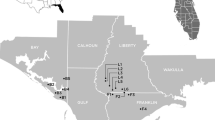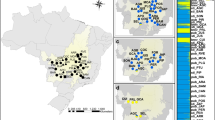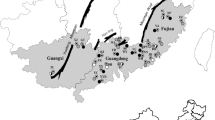Abstract
The annual hemiparasiteEuphrasia stricta occurs on Gotland in two early-flowering meadow varieties.E. stricta var.suecica is on the Swedish red-list as endangered, occurring in Sweden only on the Baltic island of Gotland. It probably has near relatives east of the Baltic proper. The other variety,E. stricta var.tenuis, has a wider distribution occurring almost all over Sweden, but is declining in abundance. Both varieties have close morphological similarities and habitat preferences, raising questions about which level conservation efforts should be focused on, varieties or populations. In this study we describe the genetic structure between and within these two varieties using amplified fragment length polymorphism, AFLP.F ST between varieties is 0.14, and between populations within the varietiesE. stricta var.suecica and var.tenuis F ST is 0.60 and 0.26 respectively. The partitioning of gene diversity to different levels shows that 14% of the genetic diversity occurs between varieties, 42% between populations within varieties, and 44% within populations. Significant genetic differentiation was detected between varieties, populations and subpopulations within populations using a constrained principal coordinate analysis.
We suggest that all of the existing populations of these two varieties on Gotland should be preserved, since they are few (6E. stricta var.suecica and 5E. stricta var.tenuis) and much of the genetic diversity is partitioned between populations.
Similar content being viewed by others
References
Altizer S., Harvell D. &Friedle E. (2003): Rapid evolutionary dynamics and disease threats to biodiversity.Trends Ecol. Evol. 18: 589–596.
Barett S. &Kohn J. (1991): Genetic and evolutionary consequences of small population size in plants: Implications for conservation. In:Falk D.A. &Holsinger K.E. (eds.),Genetics and conservation of rare plants, Oxford University Press, Oxford, pp. 3–30.
Bensch S., Helbig A.J., Salomon M. &Siebold I. (2002): Amplified fragment length polymorphism analysis identifies hybrids between two subspecies of warblers.Molec. Ecol. 11: 473–481.
Booth R.E. &Grime J.P. (2003): Effects of genetic impoverishment on plant community diversity.J. Ecol. 91: 721–730.
Booy G., Hendriks R.J.J., Smulders M.J.M., van Groenendael J.M. &Vosman B. (2000): Genetic diversity and the survival of populations.Pl. Biol. 2: 379–395.
Chakraborty R., Haag M., Ryman N. &Stahl G. (1982): Hierarchical gene diversity analysis and its applications to brown trout population data.Hereditas 97: 17–21.
Cousins S.A.O., Lavorel S. &Davies I. (2003): Modelling the effects of landscape pattern and grazing regimes on the persistence of plant species with high conservation value in grasslands in south-eastern Sweden.Landscape Ecol. 18: 315–332.
Ekstam U., Aronsson M. &Forshed N. (1988):Ängar. Om naturliga slattermarker i odlingslandskapet (Natural hayfields). LTs förlag, Stockholm.
Ellstrand N.C. &Elam D.R. (1993): Population genetic consequences of small population size — Implications for plant conservation.Annual Rev. Ecol. Syst. 24: 217–242.
Eriksson O., Cousins S.A.O. &Bruun H.H. (2002): Land-use history and fragmentation of traditionally managed grasslands in Scandinavia.J. Veg. Sci. 13: 743–748.
Felsenstein J. (1993):PHYLIP (Phylogeny Inference Package) version 3.6. Distributed by the author. Department of Genetics, University of Washington, Seattle.
Ferson S., Rohlf F.J. &Koehn R.K. (1985): Measuring shape variation of two-dimensional outlines.Syst. Zool. 34: 59–68.
Fischer M., Husi R., Prati D., Peintinger M., van Kleunen M. &Schmid B. (2000): RAPD variation among and within small and large populations of the rare clonal plantRanunculus reptans (Ranunculaceae).Amer. J. Bot. 87: 1128–1137.
Fischer M. &Matthies D. (1998): RAPD variation in relation to population size and plant fitness in the rareGentianella germanica (Gentianaceae).Amer. J. Bot. 85: 811–819.
Fischer S.F., Poschlod P. &Beinlich B. (1996): Experimental studies on the dispersal of plants and animals on sheep in calcareous grasslands.J. Appl. Ecol. 33: 1206–1222.
Fredén C. (1994):National atlas of Sweden, Geology. Almqvist & Wiksell International, Stockholm.
Gärdenfors U. (ed.) (2000):The 2000 redlist of Swedish species. Swedish Species Information Centre, Uppsala.
Hooftman D.A.P., van Kleunen M. &Diemer M. (2003): Effects of habitat fragmentation on the fitness of two common wetland species,Carex davalliana andSuccisa pratensis.Oecologia 134: 350–359.
Hufford K.M. &Mazer S.J. (2003): Plant ecotypes: genetic differentiation in the age of ecological restoration.Trends Ecol. Evol. 18: 147–155.
Hultén E. &Fries M. (1986):Atlas of North European vascular plants: north of the Tropic of Cancer 2. Koeltz Scientific Books, Königstein.
Jørgensen T.H. (2002): The importance of phylogeny and ecology in microgeographical variation in the morphology of four Canarian species ofAeonium (Crassulaceae).Biol. J. Linn. Soc. 76: 521–533.
Karlsson T. (1984): Early-flowering taxa ofEuphrasia (Scrophulariaceae) on Gotland, Sweden.Nordic J. Bot. 4: 303–326.
Karlsson T. (1986): The evolutionary situation ofEuphrasia in Sweden.Acta Univ. Upsal., Symb. Bot. Upsal. 27: 61–71.
Karlsson T. (1992):Euphrasia stricta var.suecica. Swedish Species Information Centre, Species fact sheets. 2003-10-20, http://www.artdata.slu.se.
Krok T.O.B.N. &Almquist S. (revised byJonsell L. & Jonsell B.) (2001):Svensk Flora (Swedish Flora). Liber, Stockholm.
Legendre P. (2002): Comparison of permutation methods for the partial correlation and partial Mantel tests.J. Statist. Comp. Simul. 67: 37–73.
Lennartsson T. (2002): Extinction thresholds and disrupted plant-pollinator interactions in fragmented plant populations.Ecology 83: 3060–3072.
Levin D.A. (1981): Dispersal versus gene flow in plants.Ann. Missouri Bot. Gard. 68: 233–253.
Lienert J., Fischer M., Schneller J. &Diemer M. (2002): Isozyme variability of the wetland specialistSwertia perennis (Gentianaceae) in relation to habitat size, isolation, and plant fitness.Amer. J. Bot. 89: 801–811.
Lönn M. (1993): Genetic structure and allozyme microhabitat associations inBromus hordeaceus.Oikos 68: 99–106.
Luoto M., Rekolainen S., Aakkula J. &Pykala J. (2003): Loss of plant species richness and habitat connectivity in grasslands associated with agricultural change in Finland.Ambio 32: 447–452.
Lynch M. &Milligan B.G. (1994): Analysis of population genetic structure with RAPD markers.Molec. Ecol. 3: 91–99.
Mantel N. (1967): The detection of disease clustering and a generalized regression approach.Cancer Res. 27: 200–220.
Martinsson M. (1999):Böisårkar u daldargras — naturvärden och vård i gotländska odlingslandskap (Natural values in the rural landscape of Gotland). Länsstyrelsen i Gotlands Län, Visby.
Myklestad A. &Saetersdal M. (2003): Effects of reforestation and intensified land use on vascular plant species richness in traditionally managed hay meadows.Ann. Bot. Fenn. 40: 423–441.
Nei M. (1978): Estimation of average heterozygosity and genetic distance from a small number of individuals.Genetics 89: 583–590.
Oksanen J. (2004):VEGAN: Community Ecology Package. R package version 1.6–5. http://cc.oulu.fi/~jarioksa/
Page R.D.M. (1996): TREEVIEW: An application to display phylogenetic trees on personal computers.Comp. Appl. Biosc. 12: 357–358.
Petersson J. (1999): {Hotade växter pa Gotland. Del 2: sarbara arter} (Threatend plants on Gotland. Part 2: vulnerable species).Rindi 2–3: 59–118.
Pritchard J.K., Stephens M. &Donnelly P. (2000): Inference of population structure using multilocus genotype data.Genetics 155: 945–959.
Pritchard J.K. & Wen W. (2003):Documentation for STRUCTURE software: Version 2. http://pritch.bsd.uchicago.edu/structure.html.
Reed D.H. &Frankham R. (2003): Correlation between fitness and genetic diversity.Conservation Biol. 17: 230–237.
R Development Core Team (2004):R: A language and environment for statistical computing. R Foundation for Statistical Computing, Vienna. URL http://www.R-project.org.
Schmid B. (1994): Effects of genetic diversity in experimental stands ofSolidago altissima — Evidence for the potential role of pathogens as selective agents in plant populations.J. Ecol. 82: 165–175.
Schmidt K. &Jensen K. (2000): Genetic structure and AFLP variation of remnant populations in the rare plantPedicularis palustris (Scrophulariaceae) and its relation to population size and reproductive components.Amer. J. Bot. 87: 678–689.
Soulé M.E. (1973): The epistasis cycle: a theory of marginal populations.Annual Rev. Ecol. Syst. 4: 165–187.
van der Maarel E. &Sykes M.T. (1993): Small-scale plant species turnover in a limestone grassland: The carousel model and some comments on the niche concept.J. Veg. Sci. 4: 179–188.
Vekemans X. (2002):AFLP-SURV version 1.0. Distributed by the author. Laboratoire de Génétique et Ecologie Végétales, Université Libre de Bruxelles, Bruxelles.
Venables W.N. &Ripley B.D. (2002):Modern applied statistics with S. Ed. 4. Springer, New York.
Vergeer P., Rengelink R., Copal A. &Ouborg N.J. (2003): The interacting effects of genetic variation, habitat quality and population size on performance ofSuccisa pratensis.J. Ecol. 19: 18–26.
Vos P., Hogers R., Bleeker M., Reijans M., van de Lee T., Hornes M., Frijters A., Pot J., Peleman J., Kuiper M. &Zabeau M. (1995): AFLP — a new technique for DNA-fingerprinting.Nucl. Acid. Res. 23: 4407–4414.
Wettstein von R. (1896): Monographie der GattungEuphrasia. Verlag von Wilhelm Engelmann, Leipzig.
Wright S. (1943): Isolation by distance.Genetics 28: 114–138.
Zhivotovsky L.A. (1999): Estimating population structure in diploids with multilocus dominant DNA markers.Molec. Ecol. 8: 907–913.
Author information
Authors and Affiliations
Rights and permissions
About this article
Cite this article
Kolseth, AK., Lönn, M. & Svensson, B.M. Genetic structure in two meadow varieties ofEuphrasia stricta on the Baltic island of Gotland (Sweden) and implications for conservation. Folia Geobot 40, 163–176 (2005). https://doi.org/10.1007/BF02803232
Received:
Revised:
Accepted:
Issue Date:
DOI: https://doi.org/10.1007/BF02803232




